|
|
Venture
|
Name:
|
Venture |
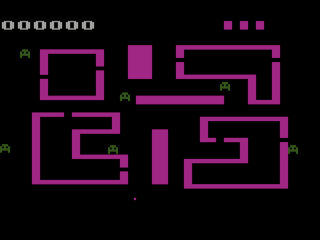 |
| Company: | Coleco (Original) Atari (Re-Release) |
|
|
Model #:
|
4L1802 (Coleco) CX-26145 (Atari) |
|
|
Programmer:
|
Dr. Joseph Biel (Commavid) |
|
| Year: | 1982 | |
|
Released?
|
Yes
|
|
|
Notes:
|
Port of the 1981
Exidy arcade game |
Venture, along with Mouse Trap, is one of Exidy's best known
arcade games. Starring a smiling little face called Winky
that must collect various treasures scattered throughout a
dungeon, Venture was the perfect fix of cuteness and fast paced
action. The simple graphics and fun gameplay made it easy
to port to the popular systems of the day. The Atari 2600,
Colecovision, and Intellivision all received fairly faithful
ports. Venture was popular enough that Atari re-released
the game in the late 80's after acquiring the rights from Coleco
when they exited the market.
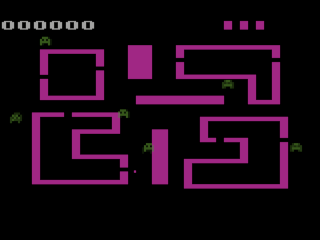
The goal of Venture is to enter each of the rooms in the dungeon, grab each treasure, and make a quick exit. Once the player has completed the four rooms on the first level they move to the second next level which has four new rooms. The two different dungeon levels then repeat until the player runs out of lives. Of course Winky isn't going to just waltz into the dungeon unmolested. In fact just getting to each room of the dungeon is a challenge in and of itself.
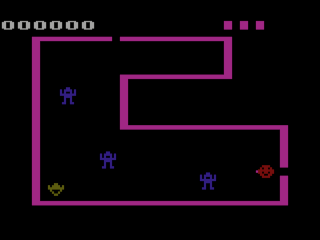
Roaming the dungeon hallways are the dreaded Hallmonsters (real creative there guys). As their name implies, the Hall Monsters move semi-randomly throughout the dungeon's hallways, blocking your passage and causing instant death if you should touch one. Unfortunately Winky can't shoot his arrows in the hallways (some sort of safety thing I'm sure), so his only defense is to dodge and try to quickly enter a nearby room. Thankfully, while quick, the Hallmonsters are quite stupid so they're usually easy to avoid. Be aware that they get faster and increasingly more intelligent on the higher levels.
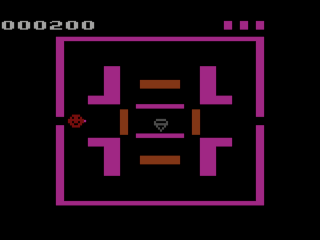
Once Winky makes his way inside a room the
game switches to a Berzerk like format. However instead of
shooting at different colored robots that all look the same,
each room in Venture has it's own theme. There's a Goblin
Room, Troll Room, Serpent Room, etc., each with a different
treasure and monster to contend with (although in the end all
the monsters act the same). There's even a special room
called the Wall Room with moving walls instead of
monsters. Winky can either try and dodge around the
monsters and grab the treasure, or he can shoot them with his
magic arrows. Shoot a monster will eliminate it from the
room, but will leave a deadly corpse for a few seconds that can
get in your way. If Winky stays too long in a room Evil Otto a
Hallmonster will appear and make a beeline for Winky.
These special Hallmosters can move through walls, so be quick
about exiting or you're toast. Thankfully Winky can exit
and enter a room an unlimited number of times to try and make a
run for the treasure.
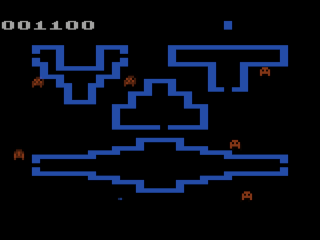
The Atari 2600 port of Venture is pretty
good considering the limitations of the hardware. The
biggest change is that the 2600 port only features two of the
three dungeon levels (due to space reasons) which makes the game
a little more repetitive than it should be. The 2600
version is also missing the treasure tally 'get ready' screen
between levels which shows all the various treasures the player
has picked up along with the room names themselves. The
monsters in the 2600 version also aren't animated like they are
in other versions, but they originally were planned to be as
seen in an early prototype. Most likely a lack of ROM
space forced the programmer to take the animation out. One
odd feature (or more likely oversight) of the 2600 version is
that the rooms are not filled in once the player acquires the
treasure. In all other versions f the game the player
cannot re-enter a filled in room making hiding from the
Hallmonsters more difficult,
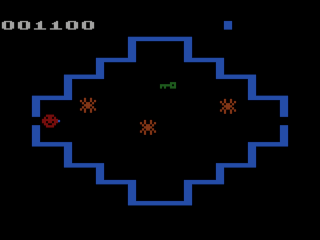
Although it has some differences from the arcade game (as most 2600 ports did), Venture plays remarkably well. Interestingly the 2600 port was programmed by Dr. Joseph Biel of Commavid. While it wasn't uncommon for 3rd party contractors to program games for larger companies (in fact most companies operated this way), it's a bit unusual for a company that had their own line of 2600 games. Most likely this was a way to for Commavid to raise money while they worked on their own games.
| Version | Cart Text | Description |
| ?/??/82 | Early Demo |
